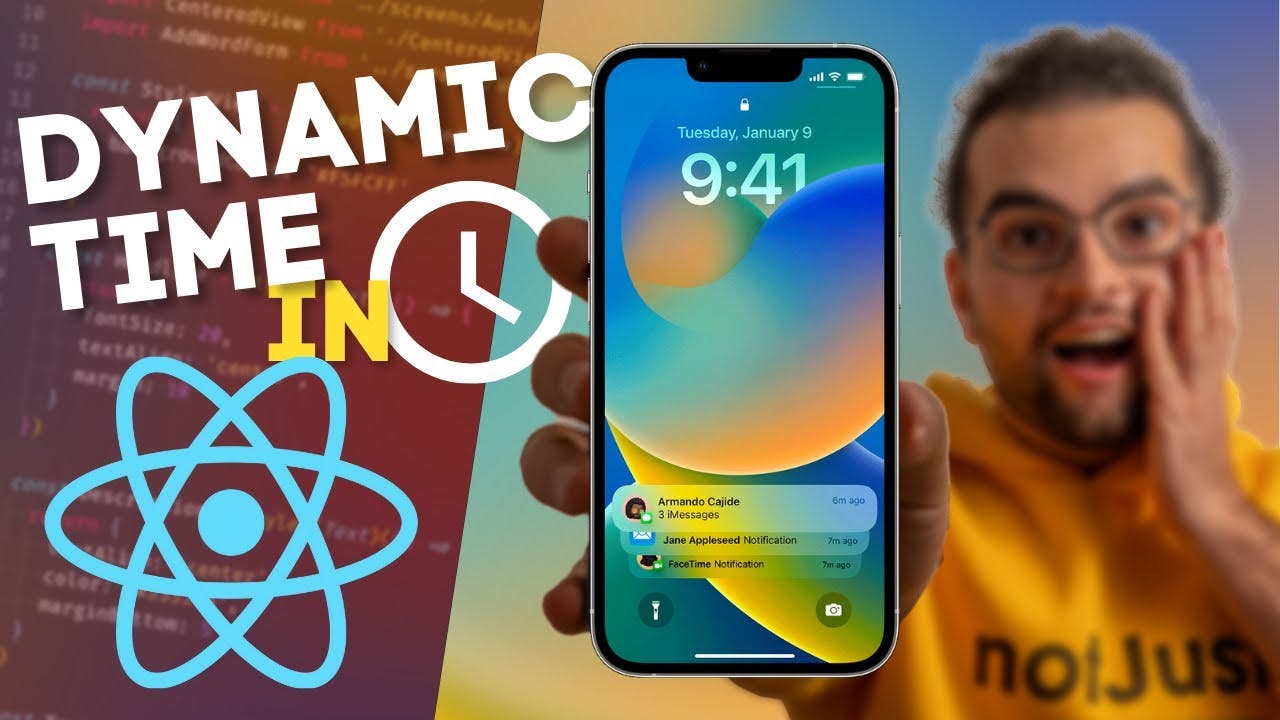Introduction
In our first part, we started with the iOS 16 lock screen and we managed to build the awesome UI together. Let’s just review what we have built so far

As you can see from the preview we built 3 main components in our screen,
- Header section → Where we show the lock icon and date-time.
- Notification list
- Footer → Where we show the flashlight and camera icon.
As of now, our date and time inside the header are hard-coded, which is not how a clock actually works! Let’s change it. We will create a dynamic time component that will give us an updated date and time. Just like the clock on your wall.
Install dayjs package
First we will do some prep work. In order to deal with date and time there are lots of libraries which help us make our life easier. In this project, we are going to use dayjs library. Why dayjs?
- It has lots of utility functions for us. Formatting, validating, and parsing dates are really simple!
- The library size is really small.
To install this library just run,
npm install dayjs
Render the date-time
Now that we have installed the library, let’s render the date-time in our header. We will use the dayjs library to get the current date and time and then we will format it to show it in our header.
- Import the library
import dayjs from 'dayjs';
- Display current date
- To display the date, we can use dayjs().format("dddd, DD MMMM") that will format the date like Friday, 05 November
- To display the time, we can use dayjs().format("hh:mm") that will format the time like 12:00
With these changes, the texts at the top of our component should be,
<Text style="{styles.date}">{dayjs().format("dddd, DD MMMM")}</Text><Text style="{styles.time}">{dayjs().format("hh:mm")}</Text>
Cool! Now we should be able to see the current date and time in our simulators or devices. However, the work is not done yet. As you have probably discovered that our date-time is not getting updated anymore after it has been rendered once.
Let’s now fix it. We don’t want a broken clock in our application. Do we?
Update the date-time
We need a couple of changes now in order to update the time.
Create a date-time state
Since we will need to update our time, we need to put it into a state variable.
import { useState } from 'react';const App = () => {const [date, setDate] = useState(daysjs()) // Initialize the date with current date-time....}
Format our date-time using dayjs
We have put dayjs() into our date state so we can use our date state to show the date-time inside our <Text /> component
<Text style={styles.date}>{date.format("dddd, DD MMMM")}</Text><Text style={styles.time}>{date.format("hh:mm")}</Text>
Update the date-time state using setInterval
We want to periodically update the date and time from the state. To do so we can use the javascript’s setInterval function. A typical setInterval function’s prototype is the following,
setInterval(() => {// function that we want to run periodicallyfunctionToTrigger();}, timeInMs);
This means that the functionToTrigger() will be called or triggered every timeInMs value. We will set the value of timeInMs and the functionToTrigger now.
As we want to update our clock every minute, our function will become,
setInterval(() => {// function that we want to run periodicallyfunctionToTrigger();}, 60000); // 1 min = 60000 milliseconds
We can write the function that will update our date-time state. Time to write our functionToTrigger() function.
setInterval(() => {setDate(dayjs()); // dayjs() always gives us the current time}, 60000);
We have our core logic set up for updating the time, where do we want to use this logic now? You might have guessed it already, since this is a side effect and it does not depend on user’s interaction we will use react’s useEffect hook.
The next question is when do we want to start this logic? We want to start our timer after our component mounts. By using an empty dependency array inside our useEffect hook we can achieve that lifecycle.
useEffect(() => {setInterval(() => {setDate(dayjs()); // dayjs() always gives us the current time}, 60000);}, []);
Awesome, with that you should be able to see your time being updated every minute. Exciting!
Preview
Before we go any further, let’s check whether our implementation is working so far, let’s update the time every seconds and show seconds in our header with the hours and mins for the sake of the demo.
useEffect(() => {setInterval(() => {setDate(dayjs());}, 1000 * 1); // 1 second = 1000 milliseconds}, []);
and change our <Text /> component to show the seconds,
<Text style={styles.time}>{date.format('hh:mm:ss')}</Text>

So cool! It’s working as expected and we can see that our timer is being updated every seconds.
Let’s revert back the code since we have already proved that it’s working!
Clean up the interval
There is one more final thing that we need to add. In our final step, we will need to clear the interval to make sure that when our application un-mounts we clean up the interval object and we do not keep it running. In order to do so we can do the following,
useEffect(() => {const timer = setInterval(() => {setDate(dayjs());}, 1000 * 1);return () => clearInterval(timer);}, []);
Note here:
- Our setInterval function returns a timer object that we want to clear, hence the variable timer
- clearInterval() is a global funciton that we can directly use, no need to import. We are passing our timer variable to clearInterval(timer) to clear the setInterval function.
Snack link
If you want, you can play with the snack below,
Conclusion
Things are taking really good shape at this point. Next part will be a bit more intense as we are going to dive into the world of animations. Stay tuned!



